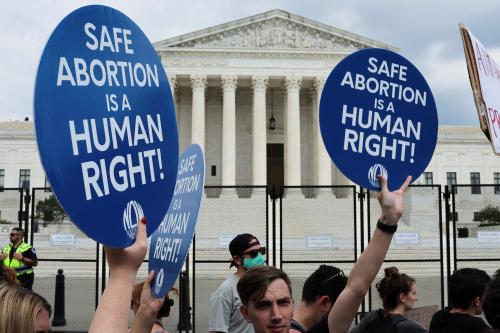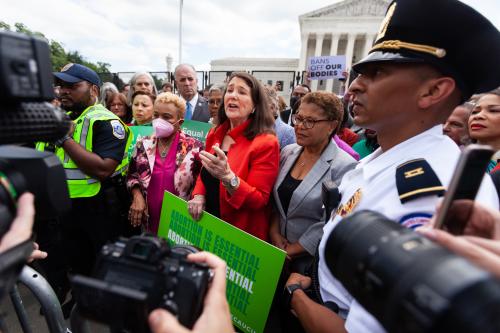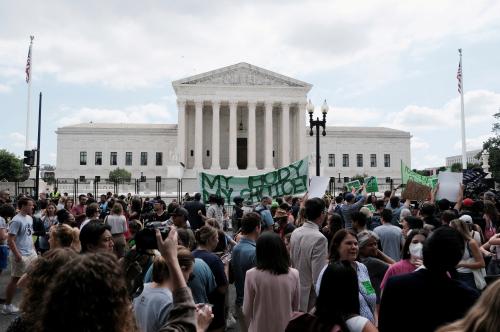I saw my first Trump 2024 yard sign in rural Ohio on the way to my 50th high school reunion last weekend. It was in a county that had cast 78% of its 2020 vote for Donald Trump and judging from the “Let’s Go Brandon” sign next to it, the homeowner was no fan of President Joe Biden. For someone like me, steeped in DC life, the visit to a deeply red area represented an invaluable opportunity to check the heartland’s political temperature and see how the landscape was faring during a volatile time. Based on a number of conversations there, I drew several observations and lessons about the current environment.
Trump hesitancy
The yard sign notwithstanding, many of the people I encountered had voted for Trump in 2020 but displayed surprising hesitancy about his possible 2024 candidacy. On the one hand, nearly all of them liked his policy agenda. They openly scorned what they saw as the Democrats’ turn to the left and Biden’s ineffectiveness in dealing with inflation, COVID, foreign policy, and border security. They wanted someone who would keep government spending in check, slow the speed of the pandemic (without mask mandates or mandatory vaccinations), and stop the flow of immigrants across our southern border.
Yet on the other hand, they didn’t like Trump’s abrasiveness, wondered what to make of the January 6, 2021 insurrection, and preferred someone who would follow Trump’s line but not antagonize so many people. Their ideal candidate seemed to be someone who supported Trumpism but with a nicer persona. In general, many of them told me they hoped Trump would not run, but that someone with his policy views would become the GOP nominee. This is consistent with data compiled by the Brookings Primaries Project based on an analysis of 2022 congressional primary candidates.
Pro-life organizing pays off
I arrived in the Midwest the day before the Supreme Court announced its historic reversal of Roe v. Wade. While most of the people I knew in DC bemoaned the decision as a betrayal of promises made during Senate confirmation hearings and a tragic rollback of women’s rights, a number of acquaintances in rural Ohio applauded the decision. Some of my hometown folks had spent decades organizing the grassroots, rallying churchgoers, running for local office, and supporting pro-life candidates financially. For them, the court decision represented the culmination of a life’s work and evidence of how their political activities over several decades had paid off. Unlike Democrats, who sometimes acted as if tweeting was equivalent to organizing, conservatives had spent decades mobilizing voters, recruiting candidates, preparing policy proposals, and financially supporting leaders who promised to enact pro-life principles.
Although Republicans were pleased with the court decision, several recognized the new abortion decision would further divide the country, generate a massive counter-offensive from progressives, and pit state against state in a dangerous manner. They wondered what it would mean for other issues such as same-sex marriage. Despite their general conservatism, they recognized that same-sex marriage had become broadly accepted in many places around the country and that conservatives did not have the same ethical ground on that topic as they did when it came to life and death debates over fetuses.
The Ukraine war cuts many ways
While most of those I encountered had relatively clear views about domestic issues, the Ukraine War was another matter. That conflict perplexes many in the heartland because they are not sure what it means for America or how it affects them personally. I didn’t encounter anyone who had a positive view of Russian President Vladimir Putin. Everyone sees him as a thug who terrorizes his own people and destabilizes global affairs. But they are not sure how the war will play out and what US involvement means for their lives.
In the short-run, the Ukrainian conflict has been a boon to American farmers. With Ukraine grain (especially wheat) blocked from the world market by Russia, grain prices have gone way up. Although American grocery shoppers are paying higher prices, US farmers are selling their stored wheat and corn at record levels. Of course, they recognize some of their financial gains are being lost at the grocery store and gas pumps, and through higher inflation on a wide range of farm costs. But U.S. agriculture is doing well due to grain supply restrictions.
Many farmers seem to be adopting a wait and see attitude to determine how the war plays out. The longer the conflict goes on, however, the greater the risk that Ukraine fatigue will set in. Putin clearly understands the fickleness of American opinion and is playing a long game to outlast US policymakers. He undoubtedly hopes Trump returns to office in 2025 and pulls the plug on the whole operation. If that happens, the Russian dictator would be free to consummate his conquest of Ukraine.
Lessons for republicans
The clear lesson for Republicans is to nominate a Trump wannabee but not Trump himself. If the latter is the nominee, there will be cross-pressures between those wanting a return of Trumpism but not the abrasiveness and acrimony associated with the former president himself. A nicer version of Trump, at least from a personality and public presentation standpoint, clearly would be the strongest GOP nominee for heartland voters. If Trump is the nominee, some Republican voters fear that campaign could reelect Joe Biden.
Lessons for democrats
The big choice facing Democrats is whether President Biden steps aside or seeks reelection. That decision, which is his alone to make, will dictate the strategic environment facing both parties. If Biden runs again, as seems likely now, the race would emphasize a complex blend of economic and cultural issues that would starkly divide the country. If Trump is the opponent, personality, age, and health issues would loom large for each nominee and play a role in the ultimate outcome. Most of my conservative friends back home view Biden as too old and not up to the job, even though the President is just three years older than Trump. Age and health clearly will be issues for either individual.
However, if Biden does not run, which my Ohio acquaintances pray is the case, it becomes an open question who will emerge as the Democrat nominee. Vice President Kamala Harris has not solidified her position as a candidate who would clear the field and be the dominant frontrunner. The people I encountered have a very low opinion of her, which is not surprising given the conservative tenor of my hometown. Many other candidates likely would run and there is no way to know in a crowded field who would emerge as the party nominee. In the wake of the Roe v. Wade reversal, there are no guarantees that a candidate from the moderate wing will triumph as happened in 2020.
The party could end up with a progressive candidate who would harness the anger unleashed by the court decision, mobilize mass voters, and make 2024 completely unlike 2020. Of course, that would fuel sentiment in the heartland that the Democrat party has been taken over by extremists and raise the level of conflict and antipathy between the two sides. The only safe prediction in that situation is a high-stakes election, record turnout from both sides, and political adversaries who neither trust nor like the opposition. If you think America is highly polarized now, it actually could get a lot worse and turn violent in ways that would shock both Americans and foreigners.






Commentary
Observations from Trumpland
June 27, 2022